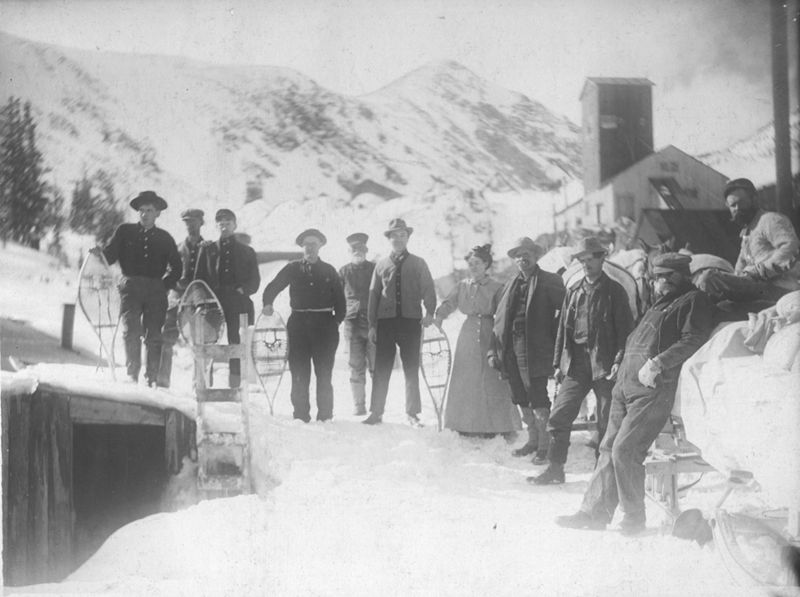Do you snowshoe? This fun winter activity can help you immerse yourself in this gorgeous state we call home. How did snowshoeing start? Where can you traverse the best trails in our area? Find out here in our latest blog with our friends at Museum of Boulder.
The history of snowshoeing
People have probably been snowshoeing in Boulder County for hundreds of years. There is evidence that snowshoeing began in North America almost 1,000 years ago, first in Native American communities and later adopted among Euro-Americans. Initially, hunters, trappers and others used snowshoes for traveling through and working in deep snow areas. Sometime in the 19th century, snowshoeing started to be regarded as a winter sport, and clubs were formed that sponsored excursions and races to promote the activity.
However, as a leisure activity, snowshoeing did not enjoy the popularity of skiing, perhaps due to the lack of speed and excitement. Plus, traditional snowshoes were often large and heavy, making them cumbersome to use. Once snowshoeing was not done out of necessity, only a small number of hardy individuals strapped on the flotation footwear for pleasure or exercise. Often these folks were climbers looking for better access to the mountains in winter.

Photo courtesy of the Carnegie Library for Local History / Museum of Boulder Collection
Local snowshoeing trails
Now, with snowshoes available in lighter and less awkward designs, many embrace the activity as a means to enjoy the quiet and solitude of the mountains in winter, when the depth of snow makes hiking impossible. In Boulder County, there are many trails excellent for snowshoeing. These trails include historical components, in addition to the natural beauty of the high country.
Switzerland Trail
Perhaps most notably, snowshoers and cross-country skiers have long enjoyed the perfect width and relatively flat terrain of the Switzerland Trail near Nederland. The Switzerland Trail is an old narrow-gauge railroad grade that crisscrosses the mountains of Boulder County, which formerly transported people, supplies and ores between Boulder and the county’s mining communities, including Gold Hill, Ward, Nederland and Eldora, from 1883 to 1919. The rails no longer exist, and portions are open to motorized vehicles, while some stretches are simply quiet lanes for hiking in the summer and snowshoeing in the winter.

Photo courtesy of the Carnegie Library for Local History / Museum of Boulder Collection
Moffat Tunnel Trailhead
Another popular snowshoeing destination is the Moffat Tunnel Trailhead (also known as the East Portal Trailhead) near Rollinsville, which starts at 9,320 feet, adjacent to where a nearly 100-year-old train tunnel bores through the Rocky Mountains. The Moffat Tunnel has allowed trains to pass through the Rocky Mountains for almost 100 years and is still an active rail line.
Hessie Trailhead
Located near Eldora, Hessie Trailhead gives snowshoers access to areas including the Indian Peaks, Devils Thumb, Lost Lake, King Lake and more. Hikers and snowshoers have long wanted access to these scenic destinations. In fact, the initial construction of the trail to Lost Lake began in 1911, several years before the formal establishment of Rocky Mountain National Park.

Photo courtesy of the Carnegie Library for Local History / Museum of Boulder Collection
Caribou Ranch
A real jewel of the Boulder County Open Space system, Caribou Ranch is excellent for snowshoeing with a historic mining complex to explore. The Blue Bird was a thriving silver mine producing high-quality ore in 1876. The mine stayed active until a drop in silver prices in 1893 made its operation unprofitable. When the Switzerland Trail railroad line was extended from Sunset to Eldora in 1905, trains brought summer tourists from Boulder to the mountains for picnics, wildflower collecting and sightseeing, so the miners’ bunkhouse was converted into a boarding house until the Switzerland Trail stopped running in 1919. The Blue Bird returned to mining off and on over the next 45 years and shut down for good in 1964. Many structures related to the enterprise remain in place.
We hope you get out and enjoy some of these Boulder area trails this winter. For a relaxing day in, visit Museum of Boulder and see their extensive exhibits of Boulder history.
This blog post was written in partnership with Museum of Boulder. All images are courtesy of the Carnegie Library for Local History / Museum of Boulder Collection.


